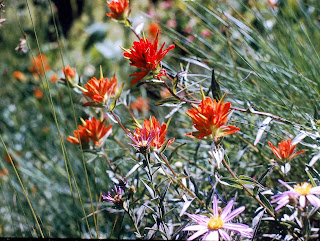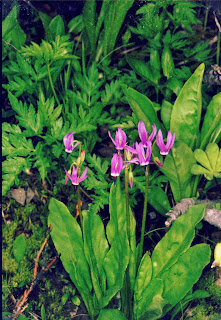 |
| Lupines, Indian paintbrush, and white daisies cover the meadows of Paradise in mid-summer. |
Paradise is covered with up to 20 feet of snow from October through May, but through the brief summer there is a constantly shifting display as different species put forth their blossoms to attract their time-share of local pollinators. Similar displays, but varying in the species composition, can be found in the alpine zones throughout the state, grading into the floras of Oregon and California to the south and British Columbia and Alaska to the north. In future installments, I will get to some of these other places, but I begin with the epicenter of Paradise. And there's no need for further chatter - I'll let the pictures speak for themselves.
.JPG) |
| In late May, the wildflower season is still weeks away. |
.JPG) |
| The national park staff who stay through the winter might be able to enter and exit buildings through the upstairs windows. |
 |
| The columbia or tiger lily, Lilium columbianum, is one of the treasures to spot in sunny spots in the forest along the road to Paradise. |
 |
| My favorite wildflower of all, Aquilegia formosana, can be seen along roadsides and in sheltered spots among the alpine meadows. |
 |
| Glacier lilies, Erythronium pallidum, are typically the first flowers to appear as the snow melts. |
 |
| Avalanche lilies, Erythronium montanum, are close relatives of the glacier lilies. |
 |
| Anemone occidentalis emerges with the glacier and avalanche lilies as the snow melts. |
 |
| Ranunculus eschscholtzii brightens up a spot of bare ground. |
.JPG) |
| Sedum oreganum grows on rocky outcrops, and is common along the road to Paradise. |
 |
| Indian paintbrush, Castilleja miniata, brings color to many parts of Washington. |
 |
| Dense leafy shoots of Veratrum viride arise in the spring. |
.JPG) |
| The small, green, lily-like flowers of Veratrum viride appear in massive inflorescences in mid-summer. |
.JPG) |
| Veronica cusickii provides blue accents in the meadows of Paradise. |
 |
| A shooting star, of the genus Dodecatheon, appear to be diving toward the ground. |
 |
| The yellow monkey flower, Mimulus caespitosus, pokes out from among rocks. |
 |
| An alpine willow is one of the few shrubs to be found at Paradise. |
 |
| Pedicularis bracteosa, the bracted lousewort. |
 |
| Penstemon menziesii is found in rocky, exposed parts of the meadow. |
 |
| Streams dissect the Paradise meadows, forming cascades and small waterfalls as they descend. |
 |
| In the 1960's there were some accessible ice caves under the glaciers around Paradise. |
 |
| At Sunrise, on the opposite side of Mt. Rainier from Paradise, the meadows are a bit drier. |
No comments:
Post a Comment
Note: Only a member of this blog may post a comment.